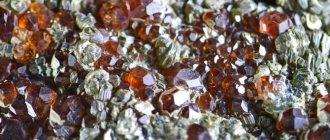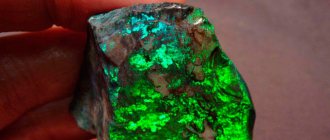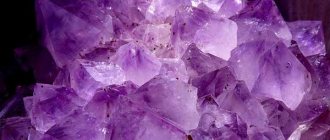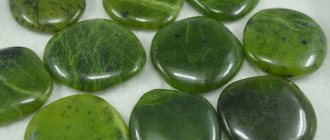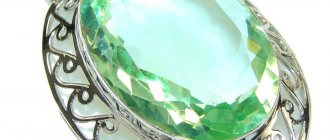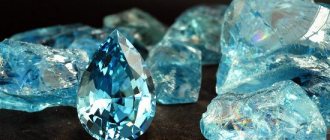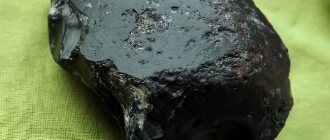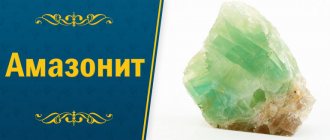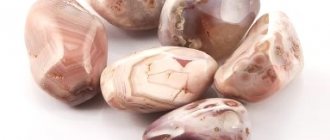Opal (quartz) is one of the most beautiful semi-precious stones used by mankind. This gem was first described by the ancient historian and encyclopedist Pliny, who could not give an accurate assessment of the color of the stone, since in the light opal has iridescence of different colors. To be more precise, opal is not a stone, since it does not have a crystalline structure, which is inherent in most gems. Opal belongs to bioliths, that is, stones of organic origin, therefore its properties are similar to amber, pearls and coral. One of the most beautiful varieties of opal is green opal (prosopal) - a rare and expensive stone.
History and origin
The most powerful magical properties of shining opal fascinated famous ancient beauties, generals and emperors. The diamond's competitor amazed with its combination of seven colors of the spectrum, flashes of lightning and quiet starlight, confirming its witchcraft status.
The Hellenes called it “a harbinger of change,” the Romans called it “bewitching the eyesight,” and the Arabs called it “broken illusions.” The translation meaning from the Latin “opalus” - consisting of particles, corresponds to the multi-colored nature of the mineral. Silica particles melted by lava in volcanic crevices create mysterious shimmers inside. Pliny the Elder wrote that the cosmic fire of opal contains a rich palette of precious crystals, which endows the owner with extraordinary mystical power.
Four legends are associated with the origin of the wonderful stone:
- The ancient Greek - the supreme deity - Zeus, having defeated the titan conspirators who intended to throw him off the throne, shed tears of happiness. Drops from the eyes of the Thunderer absorbed the twinkling of stars, the flash of lightning, and the tenderness of morning dew. The Greeks believed that the properties of opal contained a particle of the power of Zeus.
- The Indian - beautiful goddess of the Rainbow ran high into the mountains, trying to escape from the pursuing men, but tripped over a rock ledge, fell and broke into a myriad of iridescent fragments.
- Australian - the creator of the world appeared on earth after creation to bestow spiritual wisdom on people. The tracks of the deity blazed with a scattering of star nuggets.
- Arabic - lightning striking watery soil freezes into ice drops. Inserted into an amulet, they protect the owner from death in a thunderstorm.
Hindus consider iridescent gems to be symbols of compassionate love. The Romans called it a sign of devotion, admiring it as black as night, with a scarlet light inside, the opal of the patrician Nonnius. This variety was also appreciated by Emperor Caligula, who decorated his crown with a fiery galaxy. However, superstitions began to creep in after the exile of Nonnius by Mark Antony, who wanted to take away his treasures, and the tragic end of Caligula. They began to blame the stone and fear the collapse of hopes, despite the fact that Emperor Constantine boldly wore a large crystal in his tiara, believing that the radiance protected royal power.
Medieval esotericists accused the gem of inconstancy and awakening base passions. Silica powder was added to wine, poisoning enemies. They dared to wear such jewelry only during the reign of Elizabeth I, although Shakespeare considered it a frivolous companion of flighty hearts. The luxurious opal "Fire of Troy", Josephine's favorite, suddenly disappeared after Napoleon was exiled to the island of Elba.
Jewelers began throwing gems into rivers because no one wanted to buy a stone that would bring fatal changes. It was not the superstitious Queen Victoria who rehabilitated it in the 19th century after the discovery of luxurious Australian copies. The beauty of the star crystal and the absence of mass misfortunes of the owners once again raised the shining jewelry to the pedestal. In the 21st century, they are encrusted with rings, necklaces, and earrings, adding bright colors to the aura, emphasizing the shades of hair and eyes.
Story. Legends and myths about the stone
Writers have compared opals to volcanoes, galaxies and fireworks.
Fans and connoisseurs of the stone gave poetic names to unusual opals: “Pandora”, “Light of the World”, “Empress”. In ancient Rome, this gem symbolized love and hope. And it was the Romans who gave the mineral the name we use to this day - “opal”, which meant “precious stone”. Advertising - Continued below
In 75 AD, the Roman scholar Pliny observed: “Some opals carry such a play that they match the deepest and richest colors of artists. Others imitate the blazing fire of burning sulfur and even the bright flashes of burning oil." He was delighted that this kaleidoscopic gemstone included the red of the ruby, the green of the emerald, the yellow of the topaz, the blue of the sapphire and the purple of the amethyst.
The opal was set into the crown of the Roman Emperor Constantine, who claimed that the stone shone in the darkness and believed that it protected his power and his life. In his many stories about opal, he mentioned one wonderful property of this stone, which supposedly allows the owner to become invisible. Naturally, because of this, opal became a talisman for thieves.
For a time it was believed that opal could preserve the life and color of blond hair.
Opal is considered the birthstone of October. And some people think that this stone should not be worn by those born in any other month. But this superstition comes from a novel written in the early 19th century (Walter Scott's Anna Geyerstein), and not from any ancient belief or experience. In fact, for most of history, opal was considered the most fortunate and magical of all gemstones because it can exhibit a play of almost all colors.
Main deposits
95% of the world's deposits are in South Australia, 80% of production is white, 15% fire and black. In second place is Ethiopia. Characteristic thin layers of the semi-precious mineral are found in Wales and Czechoslovakia. The development of other varieties is carried out in Guatemala, Mexico, the USA, Turkey, Kazakhstan, and partly in the Kamchatka region of the Russian Federation and Ukraine.
RELEVANT: Stones for Virgo – which one to choose
Application
Milk opals are widely used in jewelry due to the variety of shades and unique beauty. They are used to make jewelry and decorative items. Transparent minerals such as hyalite are cut into convex round, oval or fancy shapes, while white ones are cut into cabochons.
The material for the frame is only noble metals - gold or silver. The final cost of jewelry with opal depends on the variety and deposit of the gem. It should be noted that the jewelry industry uses only precious species, the extraction of which is very difficult.
Decorative or interior items are created from natural semi-precious minerals or specimens with flaws, for example, stands, various figurines, boxes, vases and much more.
White opal is an iridescent original stone with magical and healing properties. Wearing jewelry will help emphasize the individuality of the owner, and will also protect him from negative energy and accidents, if you do not forget to take care of the mineral.
Physicochemical characteristics
Silica has an amorphous structure without a crystal lattice. It easily permeates the ancient skeletons of lizards, rodents, and plants, solidifying into bizarre shapes. The effect of opalescence is a spectrum-scattering color of internal radiance with a hardness of 6.5 and a density of 2.5 on the Mohs scale, requiring careful grinding. White gems have a scarlet, blue, greenish tint, black gems have a rainbow glow, and fiery gems have an orange-brown glow. 15% of water in noble specimens gives transparency and glassy shine, the rest is considered semi-precious with a rich, waxy tint.
Opal Clarity Scale
| 1 | Dim |
| 2 | Indistinct |
| 2,5 | Vaguely clear |
| 3 | Clear |
| 3,5 | Distinctly clear |
| 4 | Very clear |
| 4,5 | Extremely clear |
| 5 | Immaculately clear |
1. Dim, barely noticeable play of light only in direct sunlight.
2. Subdued play of light in dim lighting and even indirect sunlight or an examination lamp.
3. Clear play of light in dim light and very good fire in indirect sunlight or examination lamp.
4 Very clear play in low light and crisp, sharp colors in indirect sunlight or examination lamp.
5. Immaculately clear, clearly visible colors in indirect sunlight or an examination lamp, and sometimes even more distinct in subdued light.
The clarity of an opal is one of the most important factors in determining its value and at the same time it is the most difficult to classify.
On the Internet, especially among dealers, there is a tendency to exaggerate the clarity of opals. Often the clarity is simply too high, especially with dealers, where we see a value of 4.7 or more in most cases. If we face the facts, we see that opals with a clarity of 4.5 do not occur in such quantities in nature. Moreover, less than 5% of opals have a clarity of more than 4.5. Less than 1% of opals have a clarity of 5. It is ridiculous to think that 95% of all opals above 4.5 clarity are sold here on the internet. What then do ordinary dealers, who are the majority, do? We just advise you to think twice when you buy a 2.5ct floral harlequin with a clarity value of 5 for $150. Even if the dealer says so in the description, think again. Too expensive? I think no. The basic rule here is: if something is too good to be true, then it is.
How does opal color occur?
In order for us to understand how color occurs in opal, we need an electron microscope. Valuable opal is formed by thin, identical spheres of solid silicon, organized into a three-dimensional lattice that “floats” in a silicon solution.
This orderliness distinguishes valuable opal from ordinary opal and gives it color.
| Noble opal at high magnification |
Light passes through the transparent spheres in a straight line, but when it hits the silicon solution, it is deflected and decomposed into its components, which produces the rainbow effect in the color of the opal. Depending on the size of the sphere, diffraction produces a different spectrum of color. It is this combination of deflection and decomposition of light rays that gives opal its color. When you move the stone, the angle at which light passes through the spheres changes and the color changes. The word “opal” itself is translated as “watch the change in light.” The way the color changes in a particular stone depending on the inclination is called the play of color.
| Diffraction of light |
The determining factor in color formation in opal is the size of its spheres. Small spheres produce blue, which lies at one end of the spectrum. The big ones are red, at the other end. The greater the variety in sphere sizes, the more varied the colors.
| Opalescence effect in opal |
Application area
The richness of the palette allows you to create fantasy multi-layered jewelry framed in gold, platinum, strict and sophisticated - in silver and jewelry alloys. Craftsmen prefer precious stones with a pronounced color, iridescence and cat's eye effects. Milky, homogeneous and translucent pastel colors are used for handmade necklaces, as well as diffusers in LED lamps.
Main deposits
Precious stones are found all over the world, but these are small deposits. The number one supplier is Australia (more than 90% of global production). Only here lies the noblest red opal. The largest opal (3.5 kg), named “Australian Olympic” in honor of the Olympics in Melbourne, was also found here.
Second place goes to both Americas, Ethiopia, and Japan. Much is mined in central Europe. Purple opal is the pride of Brazilian mines.
Colors and varieties
Volcanic silica is divided into three types - precious with a bright play of color and shine, semi-precious - paler, ornamental - dull, matte. The first two varieties are rich in a rich range of blue-green, orange-scarlet, emerald-violet, pearlescent-star transitions.
Noble luminous stones are divided into 9 subspecies of characteristic shades:
- Peruvian - juicy turquoise, bluish-light green tints.
- Cat's eye - pearly yellow, blue-scarlet flashes, shining vertical stripe.
- Fiery - the color of a blazing fire or sunset sky, whitish inclusions.
- Black - expensive inky blue, coffee, flashes of red and blue.
- Lechos-opal – apple-colored, pine-green veins.
- Harlequin is a transparent crystal, red, blue, golden sparkles create a fancy mosaic.
- Royal - burgundy-red, emerald border, light green specks.
- Matrix – chocolate base, splashes of blue-turquoise tones.
- Girazol - similar to a tear, bluish reflections.
Simple minerals are impenetrable, pearly white with a blue tint, red-green, honey-orange: cacholong, prazopal, hydrophane, dendrite, opal jasper, silica onyx.
Varieties of opal
Despite the variety of colors, all representatives have some common features. With their help, varieties of opal were identified. Each group includes a whole list of possible colors. It is customary to distinguish the following varieties:
- White. It stands out among other colors due to its low transparency. Color varies from pure white to milky. Noble white specimens are often found.
- Hyalite. It stands out for its complete transparency. This variety is sometimes confused with other minerals. Hyalite has the same physical properties as other types.
- Baudelaire. It has unique features and is one of the most valuable types of this gem. The basis for the formation of the mineral is wood.
- Noble. This variety of opal is extremely popular. The main property of noble stones is opalescence, i.e. play of color.
- Hydrophane. Also called water opal. The initial color can be any. When moisture is absorbed, the mineral becomes more transparent and acquires a brighter color.
- Jirahzol. A translucent pure gem, the color of which is most often white or with an admixture of blue. It is noble, but is isolated as a separate variety due to a different manifestation of opalescence. The flow of colors is most often wavy, the highlights are predominantly red.
- Fiery. Has a unique shade. Can be transparent or translucent. The color is relatively evenly distributed over the entire surface of the mineral. When opalescent, the luster is most often green or yellow.
- Cahalong. Representatives of this variety contain a large number of impurities. The color is exclusively white, with possible admixture of yellow or gray shades. It has extremely low transparency.
The original color of opal is very diverse: white, blue, turquoise, red, red, yellow or even pink. In many types, bright black stripes can be seen. These varieties include the lesser-known irisopals and Peruvian opals. Black stones are of the Baudelaire variety.
Magic properties
Opal is a witchcraft stone that has protective properties and destructive powers for malicious, depraved minds. He faithfully serves creative, charismatic individuals with pure thoughts, inspiring and protecting from envious people. The crystal will create a flow of energy that carries workaholics, ambitious and talented people who are ready to live at a frantic pace to the top. Cautious introverts will not be able to cope with the intensity of passions, and evil schemers will feel the boomerang effect of personal negativity.
The magical properties of opal stone are directly related to the color scheme:
- Black, a talisman of passionate, witty leaders, is more suitable for high-status men or career women. A bunch of pure cosmic energy is used by sorcerers, penetrating the subconscious, controlling the flow of power purposefully for destruction or creation. The golden frame includes the thirst for profit, unbridled courage, pushing into casinos, hot spots. Silver extinguishes the dangerous properties of opal.
- White – protects, helps develop virtuous qualities, enhances healing abilities.
- Blue, blue - give charm, eloquence, bring good luck in love and friendship.
- Fiery orange - men are endowed with charisma, confidence, girls - wisdom, courage, femininity.
- Pink – attracts loving, kind-hearted partners, drives away anxiety and suicidal tendencies.
- Green is a magnet for wealth and favorable opportunities for financial growth.
The symbol of devotion will strengthen marital trust. A keychain with a sparkling stone is an excellent gift for a young lover, confirming the sincerity of feelings. Silica of any shade strengthens memory, attentiveness, increases the endurance of athletes, as well as organizational abilities.
Legends about the collapse of hopes are unsubstantiated. Esotericists are sure that the star mineral returns evil to tyrants, so emperors and courtiers were among the victims. A gold ring with a coffee-black crystal is an amulet for magicians and millionaires, and with a white one is a talisman for doctors and healers.
RELEVANT: Zircon is a natural double of diamond
What kind of NOBLE opals they are
All gem quality gemstones are called noble.
Noble opal is distinguished by the fact that it has a special opalescent effect, as well as often a play of color, which was noted in the previous topic.
Black opalThe difference between black and other opals is that the massive jelly-like material is necessarily on an opaque dark substrate, which creates a dark background. |
Crystal opalAn opal with a clear crystalline appearance, allowing one to see into the depths of the stone. The small base is transparent. |
Jelly opalJelly opal is a solid opal that is very translucent, almost transparent. They look like they are made of jelly and have vague colors. |
BoulderBoulder is similar to black opal, with the difference being that the opalescent layer is very thin and was formed on an ironstone, giving it the appearance of black opal on top. |
StabilizedNatural opal that has undergone some chemical treatment. |
FossilsOpalized shells, teeth, sea creatures, bones and other objects may also become opalized over time. |
Opal is a stone that matches your zodiac sign
Astrologers call the shimmering gem a talisman of happiness for Libra and Scorpio of the first decade born in October. Patron planets are Jupiter, Moon and Venus. The secret of the attractiveness of pearlescent silica is the combination of colors and energies of the four elements, giving rise to almost tangible magic and the desire to become its owner.
But the properties of the opal stone are suitable for the zodiac sign of only 10 constellations, ennobling problem areas with a magical radiance. With his help:
- Taurus - experiences the happiness of mutual love, sexual pleasure. Long-standing relationships will sparkle with new colors, friends and like-minded people will appear. Change is perceived as an adventure, not a stress.
- Gemini - will overcome split personality, acquire stable principles, and reveal forgotten talents. Intuition and business success will become permanent.
- Cancer - will take the path of loyalty to family values, leaving behind harmful addictions. Will develop attentiveness, foresight, emotional balance.
- Virgo - you will find yourself in a cycle of interesting events, new people and offers. Excessive criticality will go away, creative courage will appear.
- Libra - will blossom externally and internally, showing talents, increasing income, attracting fans. The aura will become impenetrable, and the ability to maintain a “golden mean” in a relationship will give you joyful calm.
- Scorpio - will learn to control the natural source of energy, the power of brilliant intellect, replacing anger, malice, and aggression with magnanimous nobility. The talisman of success will be a black or red stone.
- Sagittarius is the only sign of the fire element that can direct the power of opal to materialize career ambitions. Enemies, sensing the flow of protective energy, will prefer to fade into oblivion.
- Capricorn - they will free themselves from internal restrictions and complexes, they will believe in happy love and a secure future. Hopes will be confirmed by an increase in financial income and pleasant, exciting meetings.
- Aquarius - skeptical barbs of judgment will dissolve in the light of love and inspiration. An unexpected revolution of consciousness will allow you to take a fresh look at the usual way of things, show ingenuity, and change your destiny.
- Pisces - long-cherished dreams of love, mutual understanding, and care for others will finally come true. The amulet cannot be worn for more than eight hours; the mind of Pisces will not cope with the influence on the third eye: a constant series of insights will immerse the consciousness in illusions.
The properties of opal stone for zodiac signs will work faster if you choose the right shade. Milky, pinkish-red, light green are suitable for Virgo, Capricorn, Libra. Blue-turquoise - Cancers, Aquarius, Pisces, Sagittarius. Harlequin - Taurus, Gemini. White is contraindicated for Scorpios. Astrologers advise putting the stone in the box from February 27 to March 30: it will re-tune to the vibrations of the cosmos and become stronger.
Opal colors
Diffraction color is the color that occurs as a result of refraction, that is, the decomposition of light into its components in the opal.
This is the color that we actually see. Color is almost everything in opal. The most desirable color of opal is red. The more intense, clear and extensive it is, the better. But the price of opal really depends on many more factors than just color. How much of each color is in a stone, how bright each color is and how clear it is, and other factors come into play when grading a stone.
Combinations of red and blue, red and green, and gold and electric blue are also highly valued. Black opal is more expensive than boulder, which in turn is more expensive than white opal. The darker the body, the more expensive the opal.
Brightly colored stones with a wide color palette are generally more expensive than those with one, even the dominant fiery red color, which in turn is more expensive than with one green, which is more expensive than with blue, and so on.
| Order of colors in the Australian opal value scale | ||
| 1. | Red | |
WHITE COLOR OPAL
There are different types of white opals, and the name “white” does not always accurately describe the color properties of this stone. In a professional environment, black opals of drill tones are also called white or light.
Black opal white tones
Opal implies, first of all, color and its play, which is very weakly expressed in white opals.
Medicinal properties
The cosmic harmony of the amulet heals the nerves - hysteria, anger, and emotional vulnerability go away. Healthy people note amazing clarity of consciousness, calmness and tranquility upon daily contact with the mineral.
The opal family effectively treats:
- eye problems – myopia, farsightedness, cataracts;
- heart pain, vascular, venous problems;
- migraines, dizziness, epilepsy (except for representatives of the Pisces sign);
- phobias, nightmares, obsessive thoughts;
- infertility, sexual impotence, frigidity (fire nuggets);
- colds, infectious diseases.
By washing with water where the white crystal has been infused for 3-4 hours, women remove negativity and restore youth to the skin. Light minerals are useful for children; they help them grow, developing talents, intelligence, and moral qualities.
Use in jewelry and stone processing
Craftsmen grind the mineral on a diamond wheel, removing convex irregularities, giving it the desired shape, then grind it with fine-grained sandpaper. 15% water in the composition requires mandatory treatment with a damp leather circle and impregnation with natural resins. Fire stones are easier to cut; the rest are ground into the shape of a round, oval, shell-like cabochon, achieving rainbow tints.
Jewelers cheat by gluing a thin plate of a noble crystal onto an onyx base, creating an “opal doublet” - the jewelry looks luxurious on the outside, but there is little magic in it. “Triplets” have a triple layer: onyx, opal layer, and a rock crystal plate for durability. Sparkling gems are always set in precious metals, creating pendants, brooches, and earrings.
FORM AND SHINE
The most common form of opal is an oval-shaped cabochon, the length of which is 40% greater than the width and the height of which is approximately 60% of the width. In practice, these exact dimensions are very rare, because nature has created opals in a much greater variety.
| Oval opal | Pear opal | Free form | High cabochon |
Opals that are perfectly oval in shape automatically command a particularly high price because valuable material has been ground down to give this shape. Typically, 40 to 60% of the raw material is lost in order to give the opal its cabochon shape.
Ovals, pear-shaped and other regular shapes will be valued higher than free-form opals because more material has to be ground down to achieve them. The cabochon enhances the external perception and increases the perceived thickness of the color-forming area of the opal. This is why dome-shaped opals are more highly prized. Black opals do not always have a cabochon; more often they are flat on top or have a very small dome.
The quality of the stone cutter's work that we see on the finished stones can greatly affect the value of the opal, which must be polished to such an extent that there are no noticeable scratches or other defects.
How to spot a fake
Gems of the 1st category are counterfeited by painting, filling opalescent glass with sparkles. It’s easy to recognize a fake – you just need to squeeze the product in your fist for a couple of minutes. A natural crystal is cold, a synthetic crystal instantly heats up, and also has two color highlights in sunlight, and not all shades of the spectrum.
It is more difficult to recognize a doublet or a triplet; a careful examination of the side surfaces with a jewelry loupe will be required. Brave buyers check with the tip of their tongue - the original does not stick to it. Air bubbles and a repeating mosaic pattern indicate a fake.
How to spot a fake
White opals are also grown artificially. Judging by the photo, milky opal, as well as upon closer inspection, is almost no different from natural opal. It is possible to recognize a mineral obtained with human participation only by its degree of hardness. If, even if you want to, you cannot classify yourself as an expert in the group of natural stones, I advise you to use simple recommendations for identifying a fake:
- Try a pebble on your tongue. This is no joke, if the opal is natural, it will stick to the surface of the tongue. If it is a synthetic analogue - no, well, for a maximum of 1-2 seconds. This trick is unlikely to be pulled off in a store, but if the opportunity arises, experiment!
- Carry a magnifying glass with you. It will come in handy when you need to examine the surface of a stone. Air bubbles inside the base are the first sign of lab-grown opal.
- Artificial white opals have a bright zonal color. Upon closer inspection, areas of layer gluing can be seen on the surface.
- Juicy, even acidic colors also indicate a fake. Natural stones have a more delicate color.
- Real white opal plays with the sun's rays, refracting them in the palm of your hand. Artificial ones do not have this ability.
- Obviously repeating patterns on the surface of the mineral are a clear sign of a fake.
How to wear and care
The cosmic mineral is alive, it goes through the cycle of youth, maturity, aging. Caring owners extend the service life by wiping the surface with a damp cotton cloth, putting on jewelry after rain, for walks and receptions near the water, which the gem also takes in contact with the human body.
Given its absorbency, the opal stone can be worn on clean skin, free from creams, oils, and detergent residues that damage the internal components of the fragile talisman. The accumulated negativity can be easily removed under running clean water. It is customary to wear rings on the middle finger of the right hand to attract good luck and awaken talents, and on the left to heal. Cracks caused by overheating can be repaired by immersing the opal in a glass of water overnight.
Care instructions
Stone requires maintaining moisture levels. In addition, opal is highly fragile. Therefore, during care you should adhere to the following rules:
- For cleaning, use only a soft brush;
- avoid contact with aggressive chemicals;
- the stone can and should be dried in the sun after washing, but this must be done carefully so that it does not become dull or crack;
- the soap content in the solution should be minimal.
To ensure that the gem has enough moisture, after cleaning it should be wrapped in a wet towel or napkin for 2 hours. If there is excessive loss of liquid, in order to return the jewelry to its previous appearance, you need to leave it in water for some time (depending on the size of the mineral and the degree of drying).
Favorable time to buy
When intending to create a good luck talisman, it is necessary to take into account the lunar phases, especially when the vibrations of a celestial body are directly related to the mineral. The diverse palette of the opal family influences the period of choice. White ones are bought on the 4th lunar day and worn on the 18th.
It is better to purchase fiery ones on the 25th day of the cycle, and wear them starting from the 11th of the next phase. Colored, impermeable, milk ones are paid for in the store on the 14th day, and the first physical contact is made on the 28th. Black, blue, pink ones are bought on the 15th day, put on for the final phase on the 27-28th day.
Solid opal
Only opal that has not been altered in any possible way except by cutting it into several working pieces, shaping it, and polishing it with a stone cutter is considered a solid opal.
All opals are solid except for doublets and triplets.
Black, crystal, boulder, fire opals are all opals that were made from one whole (not glued) piece of raw material. Even those opals that naturally consist of two parts, such as black opal (which consists of a crystalline dome and a dark base) are solid.
The matrix boulder consists of a gonglameret opal with an iron stone, but it is also a solid opal because nature created it that way.
There are opals that in their natural form are pale and fragile, but after chemical modification they acquire a completely marketable appearance. These are also solid, although modified opals.
